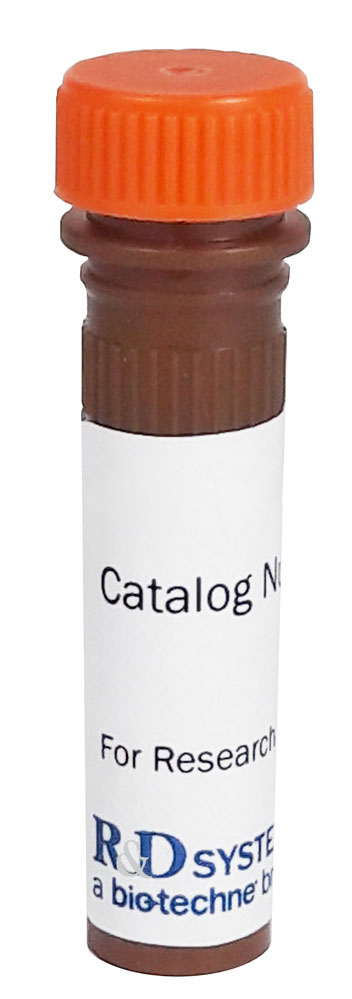Recombinant Human Cryptic Protein Summary
Product Specifications
| Human Cryptic (Tyr26 - Gly169) Accession # NP_115934 |
Asp | 10-His tag |
| N-terminus | C-terminus | |
Analysis
Customers also Viewed
Product Datasheets
Carrier Free
CF stands for Carrier Free (CF). We typically add Bovine Serum Albumin (BSA) as a carrier protein to our recombinant proteins. Adding a carrier protein enhances protein stability, increases shelf-life, and allows the recombinant protein to be stored at a more dilute concentration. The carrier free version does not contain BSA.
In general, we advise purchasing the recombinant protein with BSA for use in cell or tissue culture, or as an ELISA standard. In contrast, the carrier free protein is recommended for applications, in which the presence of BSA could interfere.
1410-CR
| Formulation | Lyophilized from a 0.2 μm filtered solution in PBS with BSA as a carrier protein. |
| Reconstitution | Reconstitute at 0.2 mg/mL in sterile PBS. |
| Shipping | The product is shipped at ambient temperature. Upon receipt, store it immediately at the temperature recommended below. |
| Stability & Storage: | Use a manual defrost freezer and avoid repeated freeze-thaw cycles.
|
1410-CR/CF
| Formulation | Lyophilized from a 0.2 μm filtered solution in PBS. |
| Reconstitution | Reconstitute at 0.2 mg/mL in sterile PBS. |
| Shipping | The product is shipped at ambient temperature. Upon receipt, store it immediately at the temperature recommended below. |
| Stability & Storage: | Use a manual defrost freezer and avoid repeated freeze-thaw cycles.
|
Background: Cryptic
Cryptic, also known at CFC-1, was originally identified as a secreted protein that is specifically expressed during mesoderm differentiation (1). Cryptic, along with Cripto, Xenopus FRL-1 and zebrafish OEP (one-eyed pinhead) define the epidermal growth factor-CriptoFRL1Cryptic (EGF-CFC) family of signaling proteins that function in cancer and various developmental processes (2, 3). Overall sequence identity between members of the family is low, but they do share distinct domains: a variant EGF-like motif, a novel conserved cysteine-rich domain (called CFC domain), and a C-terminal hydrophobic region (2). Most EGF-CFC members have a glycosyl‑phosphatidylinositol (GPI) anchoring site at the C‑terminus and exist as extracellular membrane‑anchored proteins. However, naturally‑occurring soluble isoforms also exist. Human Cryptic shares 55% and 25% amino acid idenitity with mouse Cryptic and human Cripto, respectively. Despite weak conservation in amino acid identity, EGF-CFC family members appear to function similarly in assays for phenotypic rescue of zebrafish oep mutants (2).
Cryptic is expressed during gastrulation in the mesoderm and later in the neuroectoderm, marking the prospective floor plate of the neural tube (1). Genetic evidence from mice and humans points to a role for Cryptic in determining left‑right asymmetry. Mutations in the cryptic gene result in a spectrum of heart, lung and spleen defects, all representing left‑right laterality defects (4, 5). These phenotypes resemble some Nodal mutant alleles suggesting that Cryptic, like Cripto, acts as an essential cofactor for Nodal signaling (1, 3). Studies have shown that other TGF-beta superfamily members involved in mesoderm induction and left‑right patterning, Vg1 and GDF-1, also require EGF-CFC cofactors. Cryptic binds to GDF-1 leading to an Act RIIB-ALK4-Cryptic-GDF-1 complex for signaling (6).
- Shen, M. et al. (1997) Development 124:429.
- Shen, M. and A. Schier (2000) Trends Genet. 16:303.
- Rosa, F.M. (2002) Science's STKE http://stke.sciencemag.org/.
- Gaio, U. et al. (1999) Curr. Biol. 9:1339.
- Bamford, R. et al. (2000) Nature Genet. 26:365.
- Cheng, S. et al. (2003) Genes & Dev. 17:31.
FAQs
No product specific FAQs exist for this product, however you may
View all Proteins and Enzyme FAQsReviews for Recombinant Human Cryptic Protein
There are currently no reviews for this product. Be the first to review Recombinant Human Cryptic Protein and earn rewards!
Have you used Recombinant Human Cryptic Protein?
Submit a review and receive an Amazon gift card.
$25/€18/£15/$25CAN/¥75 Yuan/¥2500 Yen for a review with an image
$10/€7/£6/$10 CAD/¥70 Yuan/¥1110 Yen for a review without an image



